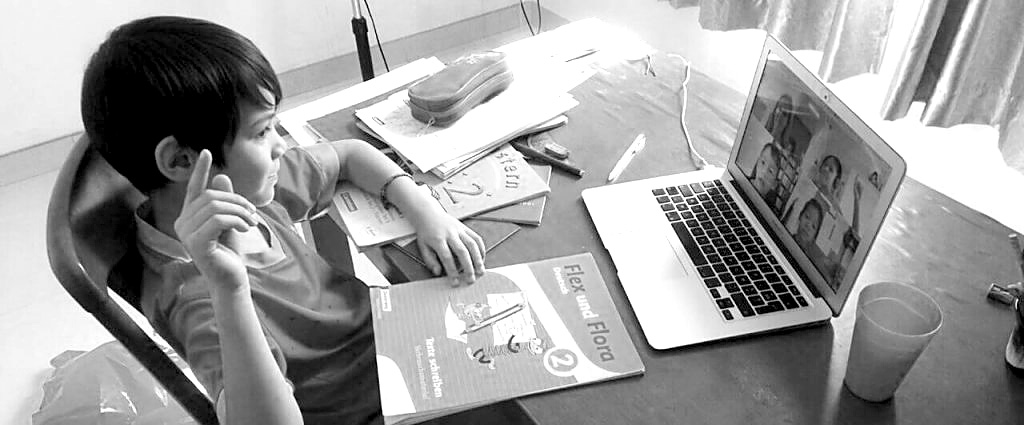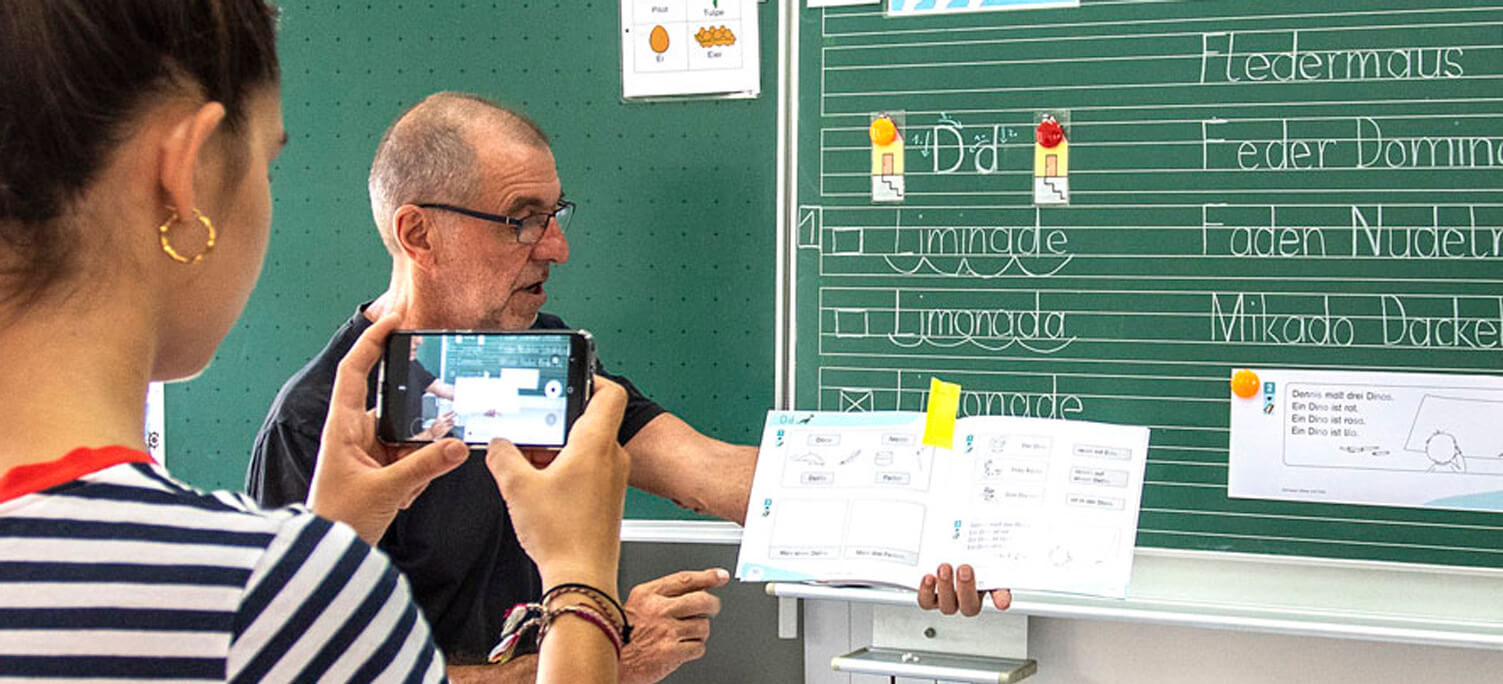
IGS_Online

Information page on ONLINE LESSONS for German schools abroad / COVID-19
We would like to share our experiences and some recommendations with other schools.
Online resources for teachers
Survey of pupils and parents as well as a scientific survey among the teachers
Questions and challenges
You should clarify the following questions before the online lesson starts:
- What ICT skills do teachers, learners and parents have?
- Which IT infrastructure can you fall back on?
- Which methodological adjustments are necessary in the lesson planning?
- How do you inform parents / guardians about the form, the procedure, the requirements and the goals of the online lessons and, if necessary, provide help for parents, students and teachers?
Requirements
What requirements did we identify before switching to online teaching?
- Establishment of a task force with ICT-savvy teachers from all school levels, possibly parents' representatives
- Ensuring a stable internet connection at school and at home
- If there is no bring-your-own-device policy (BYODP), the availability of laptops / possibly tablets (class 1-3) must be ensured. Cell phones are unsuitable as replacements.
- Instructions for setting up the workplace at home, consisting of an online workspace and an offline workspace, a comfortable seat and good lighting conditions
- Secure the use of headphones!
- Establishment of an online help desk (EdTech-Coach is logged into all virtual classrooms and is available as a contact person.)
- IT help desk for technical support (problems with the internet connection, hardware, etc.)
- Collection of material packages / textbooks must be arranged. (Screen time should be reduced, especially in online lessons. It is therefore important that the children have access to traditional books.)
- Ensure breakfast, lunch and afternoon snack (if necessary, contact parents)
- Useful tutorials for teachers:
- Google Classrooms / Moodle
- Zoom / Google Meet
- Creation / sending of videos
- Seesaw (Grades 1-3)
Online Classroom Setup
If the above conditions have been created, continue here with:
- the establishment of virtual classrooms (if not already available), e.g. with Google Classrooms or Moodle
- E-mail to the pupils / parents with the online timetable (click on the subject) and navigation to the class teacher's virtual classroom. The first online lesson is a class teacher lesson, in which specifications for the implementation of the online lesson are given:

IGS_ONLINE METHODOLOGICAL CONSIDERATIONS
Specifications for online lessons
- All pupils wear headphones.
- To avoid background noise, the microphones of the pupils must initially be switched off. (Practice switching on and off with pupils in the lower classes once)
- Every lesson begins with a greeting and ends with a farewell.
- Control of attendance (class registers, electronic class register, if necessary the school office contacts the parental home if pupils appear too late or not in the virtual classroom.)
- Only one person speaks at a time!
- Rules for using the chat function (users like to chat while the teacher explains. ;-))
- Mobile phones may only be used for teaching purposes, e.g. for taking photos / WhatsApp functions.
- Information on how close feedback or an evaluation of the services is carried out
Methodical information on learning progress surveys / exams
- Instruction on attempted fraud / Academic Honesty (closing chats, etc.)
- Drive through the room / work area with the camera before the test begins
- Watch writing phases with camera / write on Google Docs to track the writing phase or handwritten texts
- Use of plagiarism software, e.g. Turn it in
- Use of tasks that require your own creativity to solve or that represent a combination of an oral and a written test
- Unscheduled questions to avoid memorization / reading / creative work orders
Opportunities for performance review
- Oral performance assessment individually or in a group
- Hourly marks for the quality of the contributions
- Implementation / evaluation of simple experiments / trials or teacher experiments with evaluation / protocol
- Creation of collections
- Marking and labeling of original preparations (plants)
- Lesson minutes
- Google Forms – live in class with a time limit
- Lecture / speech / presentation in the online meeting or
- Creation of a learning video on a given topic
- Creation of a quiz in Quizlet for the classmates
- Creation of for a wiki (e.g. with Wikimedia)
- Creation of a podcast on a topic
- Exit tickets
- Creative texts
- Conduct an interview
- Homework
- Prepare and conduct a discussion online
- Creation of a blog on a topic
- Developing questions about the text
- Prepare scripts / storyboards
How can you reduce screen times in online lessons?
- Idle work phases next to the computer
- Use of textbooks and worksheets
- Conducting interviews
- Development of a puppet show which is recorded
- Working with weekly plans
- Free tasks on which the pupils work long-term
- Listening or reading assignments
- Production of audio texts
- Creation of educational posters
- Writing concept
- Attempts to make observations with protocol, drawing objects and labeling
- Practice staging and create a video
- Educational videos for classmates
- Learning diaries offline
- Handwritten texts -> screenshot
- Collections / sections / experiments / plants etc.
- Drawings
IGS TV
We chose YouTube platform to publish our video educational content, and to make it publicly available.
The platform offers many advantages, such as convenience of use for publishing, student familiarity with the player, and the possibility to organize educational topics into playlists.
Furthermore, in an attempt to avoid student distractions and facilitate browsing of our various video playlists, we’ve created a dedicated TV page on our website, regrouping all video educational materials and school related events.
What recommendations do our teachers give?
Reduction of screen times
In order to reduce screen time, the pupils also use textbooks and workbooks in idle phases.
Parental support.
Involvement of parents
In grades 1-3 required (possibly 4-6)
Work phases
Joint entry (with picture and sound), development phase (without picture and sound), joint conclusion (with picture and sound)
Responsiveness of teachers
The teacher can be contacted in all phases and is available to the pupils if they have any questions. (only in writing, as otherwise everyone else will be disturbed) – the opportunity for discussions between individual pupils and the class is necessary so that the other pupils are not disturbed by interim questions.
Mobile phones
PC, laptop or Ipad; Mobile phones are only suitable as support
Textbook or copy on screen?
Even if the respective task can be found in the textbook or workbook, it is advisable to photograph it in advance and then discuss it with the pupils on the shared screen (the pupils look at the screen and thus at the teacher and not downwards her book).
Securing results
When introducing new lesson content, e.g. in mathematics, discuss the respective task together on a shared screen and at the same time enter it correctly on the page so that the pupils definitely write down the correct solution.
Work in small groups (gr. 1-3)
Division of the class into groups, duration per class time for classes 1 to 3 a maximum of 45 minutes, longer break offline and planning exercises until the next class time.
Teaching materials before class
Remind younger pupils of the necessary materials shortly before the start of the lesson so that they do not just start looking for them after the lesson
Create contact opportunities
During the development phase, pupils can report via the chat or briefly via the microphone.
Settings
Pupils may not change any settings in online lessons without the express permission of the teacher (if the platform allows this).
Physical balance
School day routine: pupils should exercise / go outside / do sport in planned phases. The sports teachers can issue work assignments for this, create video clips, etc. (Pay attention to domestic conditions: playground / sports areas / pool in the house / in front of the front door)
There practical exercises from art and music lessons, e.g. body percussion.
What insights have we gathered?
SUPPORT FROM PARENTS
In the lower classes, depending on the skills of the students, more or less support from parents is required.
Silence is Golden
Background noises are to be avoided by students a) wearing headphones b) microphone only switched on when necessary b) a quiet work environment.
Importance of social interaction
The lack of interaction at school must be compensated for by the parents in a targeted manner, e.g. through excursions, games evenings together, etc.
Balance and movement
It is imperative that the pupils take part in other sports activities via online gymnastics sequences or swimming.
Spectators in the online classroom
Classrooms are usually private rooms. In online lessons, siblings, parents, visitors and pets are also involved.
Non-verbal feedback is sometimes missing
In the virtual classroom it is much more difficult and sometimes impossible to interpret eye contact and body language as signals of understanding.
Students respond differently to online lessons
Some students are more concentrated because of the headphones, sometimes otherwise shy students become significantly more active in online lessons; the opposite occurs with other students.
ICT skills are a success factor
Existing ICT skills are important success factors for a quick changeover to pure online teaching. (At the IGS, ICT is taught as a school subject from grade 3. All students have an e-mail address. Interactive textbooks are used in history, geography, and some German classes. The classrooms are equipped with Apple TV.)
Teachers need to adapt teaching methodology
The teaching methodology online is different from the one in classrooms. (Raise your hand if you did not understand something is replaced by “Send me a message. Etc.)
Online lessons require self-organization
Online teaching requires a higher degree of self-organization on the part of the learners.






STATEMENTS FROM OUR TEACHERS

“As an EdTech Coach, I am thrilled with how much motivation and without any objections the teachers of all ages have switched their lessons to igs_online. Above all, the size of the teaching staff and the mostly manageable class sizes made a quick and efficient changeover possible. Both teachers and students were able to fall back on their many years of experience at the IGS with the Google Suite for Education and by combining several applications, the planned transmission of the subject matter and often even different social forms could be retained.
As a team, igs_online has certainly welded us together and promoted the exchange of experience and working methods. Despite the sense of achievement, we look forward to welcoming the students again soon in more than two dimensions.
By the way: As a DAF / DaZ responsible person, I have been publishing a weekly DaF newsletter with online resources for the pupils for 3 years. You can find the latest issues here.“
Franziska Barnickel, Former Coordinator IB, DaF / DaZ, EduTech

“Even in elementary school, online lessons can be implemented sustainably and profitably for all parties. Unlike in secondary school, you cannot of course convert the timetable directly into an online timetable. In contrast to lessons in the real classroom, it is important to divide large classes into smaller groups for online lessons. The group size should not exceed seven for high performing students. An optimal group size is 3-6 learners. Experience shows that a learning group that is as homogeneous as possible facilitates online teaching and enables lessons to be adapted to the group, so that the teachers can focus on topics specifically relevant to those groups.
As already mentioned, an adapted timetable must be created for online lessons. So-called core times have proven their worth. For grades 1 and 2, a work phase of 30 minutes, followed by a 15-minute practice phase, seems to make sense. The contents of the timetable are also reduced to the so-called core subjects German, Mathematics, specialist knowledge and English, which can be easily covered online. It is interesting to note that the teaching phases, which serve to create rhythm, hardly differ from the real teaching, in which a ritualized entry into the lesson as well as a joint conclusion means, in addition to the educational value, also a check of attendance.
Contact with parents and close communication with them is an important feature of good online teaching. If necessary, there can be short information letters with general information and homework every day. Close cooperation to support the students is particularly important in class 1. For older classes (3 and 4) there is an email at the beginning of the week with link tips, announcements of important tests and class work to the parents. At the end of the week, parents receive a short summary of the week. Alternatively, communication via Seesaw is an option. Messages to parents, private messages, posts for the students, information about homework, weekly assignments, use of new websites and apps as well as reminders of forgotten tasks run through this application.
The question of selecting the right application arises in those classes in which no ICT lessons have yet taken place. For grades 1-3, Skype is the ideal starting point. Most parents have a Skype account, so setting it up is little or no problem. The screen can be split edited. Google Meet with grades 3 and 4 has also proven its worth. No registration is required. The first session can take place together with parents and pupils via a link to the parents. In the first session, rules and technical skills are discussed. The screen can also be shared with Google Meet, which facilitates the visualization, especially in DaZ / DaF and worksheets can be edited one-to-one on the screen.
In order to make things easier for parents and pupils, the smallest possible number of apps should be used within a class. So don’t switch between Google Meet and Skype. Alternatives would be Zoom, Webex or Teamviewer. We don’t actually need the functions these applications offer for primary school students.
Heide Schaffer, Head of School, Head of Primary School
